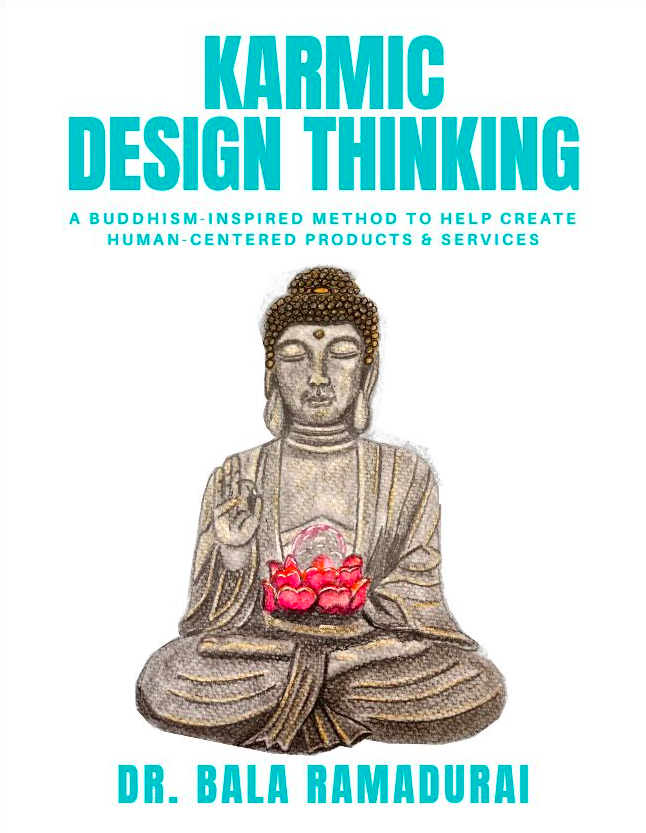2016-12-08

Let me stoke your curiosity. I have an important reason to write this series of posts on Karmic Design Thinking. Please promise that you will be patient.
Design is ubiquitous and is all around us. A tree is designed to bear the entire weight of the tree on that one single trunk. Ok, you can really say that, well, design is a conscious process. In my opinion, designs evolve naturally, either by nature or by human intervention. And since we are all part of nature, it is one and the same. Talk about talking in circles.
Design Thinking is using this kind of thinking in everything around and that could include design. Phew! I am glad that is out.
Right, right, the reason for the series of posts. I am coming to that, there is no need to yell at a device for that. Ready or not, here’s the story of why I felt that this series had to be written.
The Story
In the early dry months of 2016, I was asked to teach a course for design thinking for a batch of about 200+ MBA students at Symbiosis Institute of Business Management, Pune, India. On top of that, the course coordinator informed me that this course was a core course which meant that all 219 of them had to starting thinking design thinking. No, I take that back, they had to go through the course and pass the course, or else they would stay back in the lovely hilly campus for another year on my account.
So, I started to redesign the course “design thinking” as I also thought my material was becoming stale and needed a fresh look. Besides, I love designing courses. Design is everywhere, I just told you a few paragraphs earlier. So “stale” was an excuse to draw up a completely new design. Since the course was 30 hours long, I split the course into 4 chunks of 7.5 hours each. Remember, I told you I prefer day long teaching rather than an hour here and an hour there. If you are a teacher, who teaches hour by hour, then you can split what I am about to describe into chunks of an hour each as well and it would still make sense for your students.
The Grand Redesign
The stages I had chalked out for the course were:
- People Orientation - you have to know what people are going through before you discuss solutions
- Problem Definition - What is the exact cause of whatever it is that the above mentioned people are going through?
- Solution Generation - How do you solve the problem effectively, smartly?
- Concept consolidation - Chalk out your next course of action
In most design courses around the world, one would add prototyping and testing to these phases. The skill sets required are different for prototyping and there is real money involved in making some of these prototypes. In the 4th stage of concept consolidation, there is some degree of prototyping, but I wouldn’t call it that yet. To me, a prototype is something that you can give an intended user to work with and find out how they react to your idea. These four stages appear before prototyping and testing, so that you are at least aware of what is that your intended audience is facing and where is that they need help.
This was done for the course and I had some associated presentation material, but I wasn’t sure how the students were going to learn from only me yakking and nothing else concrete to latch on to.
Different Strokes for Different Folks
I had to satisfy three types of learning styles - visual, auditory and kinesthetic or learning by doing. By way of the course, visual and auditory styles were going to be satisfied. Audio - my speaking and video - some interesting videos on the internet. What about the kinesthetics? What about the ones who wanted to learn offline, you know, by not coming to a class, but still want to pick up design thinking? Wink… Wink… Well, to an extent kinesthetics would benefit from the activities in the course, but offline students left a big void for me. I built a companion course website using moodle. This worked for the students to some extent, but I felt that they needed a manual, a treatise or a go to repository of information if ever they got lost designing something. Besides, if I want to jot down every little detail so that I don’t have to remember it. Hence, I decided to document my methods in a series of posts or better still a book. Besides the internet and books usually have a wider and better reach than my physical presence. Also, I would just point these pesky students to the book/posts and yell at them -
RTFM - “Read the friendly manual”
Self-Doubt
What I wasn’t sure of was if this course/book/posts design that I had written down is valid and if it would stand the test of time. I got a bit jittery at this point with thoughts like what if this model fails after a few months.
How could I get the ideas presented here validated?
Can I get it validated by a known expert and without spending a dime or writing long emails?
I needed a proverbial apple to fall on my head to assure me that all was well with my design.
And…
The next exciting episode of Karmic Design Thinking is covered - Karmic Design Thinking - Part 2 - What is it? to know what I have in mind.






